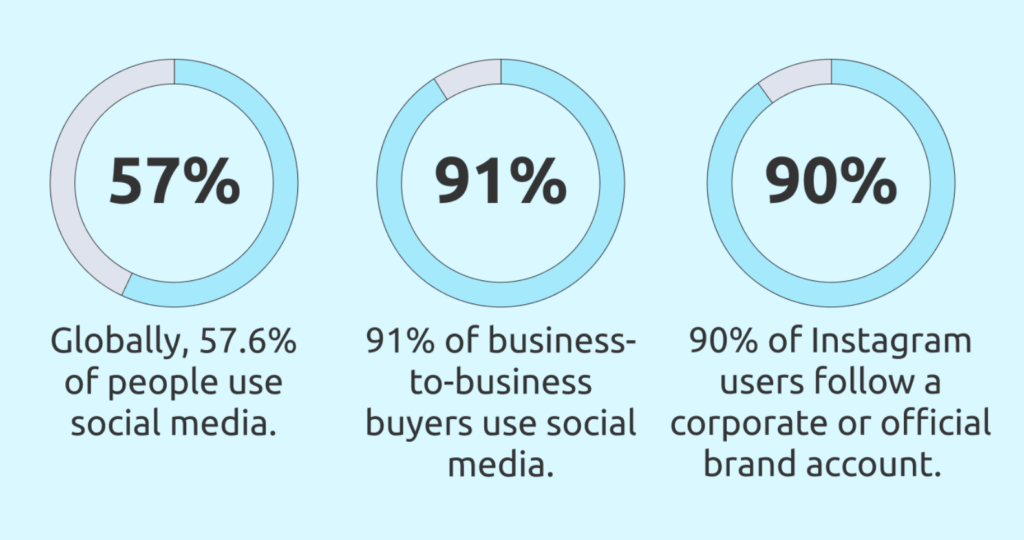Let's talk about you.
"*" indicates required fields

Social media has become the most influential space where social channels aren’t only used for “social networking” but to advertise brands and products digitally. Building a brand is the desire of many small businesses, but one of the vexing challenges often faced is utilizing the power of social media to enable brand recognition.
If you’re a small business entrepreneur able to leverage the power of social media branding, you can open the door to building a robust network of loyal customers and long-lasting relationships online, create brand awareness, stand out from your competitors, and bring conversions for your business.
With more than half of the world now using social media, and the average time spent is 2h 27m on social channels daily by users, it’s becoming critical for businesses to explore a social media strategy.
Branding is an essential stage for any entrepreneur looking to generate long-term business, and it’s all about defining HOW your unique brand stands out from the rest. Ever notice how people say Kleenex when they really mean tissue? Crock-Pot when they’re talking about a slow cooker? Successful companies like these have nailed down solid brand positioning. It affects how consumers view your product and how much they’re willing to spend.
While there are countless brand marketing strategies to explore – social media branding is one of the most effective – and the stats speak for themselves.
 Statistics via Hubspot and Businesswire
Statistics via Hubspot and Businesswire
Identifying your brand and knowing it to the core will be a critical asset in helping to distinguish yourself from your competition.
Ask yourself – What defines my brand identity? How does it differentiate from the others? What are the values of my company? If you’re overwhelmed by these questions, our team of brand strategists can guide you in the right direction (check out the how-tos of building brand awareness and the basics of brand building in our blog about Six Proven Strategies to Build Brand Awareness). The more crystal clear you are about your brand’s identity – the easier it will be to craft the proper messaging for your audience and identify the audience personas you should be speaking to!
According to HubSpot:
We suggest diving into your own research on the different social networks to gauge where your audience is on.
Is your goal to sell a product/advertise a service? Drive traffic to your website? Communicate and build relationships with your clients?
Most businesses focus on three objectives: customer engagement, generating more revenue, and improving the customer experience. Whatever the objective is for your business – get clear on it so you know what content to post online and can track and analyze your progress and pivot when necessary.
You’re probably eager to create social media accounts now that you’re clear on your brand’s identity and the message you want to deliver to your audience.
Before you get too excited, the number one mistake we see businesses make is creating accounts on every single platform and not posting regularly. Managing multiple social platforms requires a lot of effort and ongoing maintenance. Instead of struggling to manage eight accounts poorly, maintain a digital presence on a few networks so you can manage them exceptionally well.
Not sure what social media channels are best for your business? Check out this thorough guide from our partners at HubSpot.
So, you’ve decided on the social media platforms you’ll be using – now it’s time to make sure you have a consistent bio, logo, and handle on all channels to build familiarity and trust.
Some businesses will change the logo styling slightly between networks depending on the interest of the specific audiences – whichever you choose, ensure your profiles have a common thread that people will recognize as YOUR brand.
Once you’ve ensured logos, banners, bios and handles on all platforms are consistent with your brand’s guidelines, audit regularly, and there’s no harm in doing some A/B testing.
Now that you have a cohesive visual presence across all accounts, you’ll also want to use the same colours and fonts in your graphics and videos. Why? So when someone visits your Instagram or Facebook profile, the overlay text fonts of a video post, blog post, or static post are familiar enough to recognize it’s you.
If you do this part well, over time, your audience will begin recognizing when a post is from your business without seeing a logo or name. This type of brand recognition is what you want to achieve for your social media branding efforts!
Aesop does a great job of showcasing its products’ moods and feeling online through imagery, fonts, and product placement. The general brand feeling is muted, earthy, and texture-based, which carries into their product’s branding. While they may mix up colour schemes and themes depending on the season – consistency carries into their Instagram stories. We suggest finding some examples of brands you follow online to get inspired.

Aesop Instagram feed
Once you’ve aligned your visual branding, how will you craft captions and copy?
We suggest leaning into the personality of your brand. Is it sarcastic and fun? Informative and educational? Mentoring and wise? You might already have established a brand voice for other marketing focuses – extend that to social media and cultivate a specific approach for different social platforms. Not every caption will be written out the same way – you might notice that your Facebook audience prefers educational long-form copy, and your Instagram audience engages more with a witty one-liner.
Get familiar with your voice and tone, continue to test, and have fun! If you have multiple people managing your accounts, having a guide to reference keeps everyone on your team aligned and consistent on the tone and voice.
You’ve increased your brand awareness across social media – great. Now it’s time to check if you’ve properly executed the strategies to reach your objectives.
We suggest paying close attention to mentions, the share of voice, and engagement – these markers show people are resonating with your message and care enough to take that next step after a follow.
Building reports can be easy – we use Eclincher’s Social Media Management Platform because of the capability to create custom-built reports vs a generic template.
It takes time and patience to build brand recognition on social media! The most recognizable brands like Coca-Cola and Nike have major brand equity because of the time and consistency in their branding efforts. Utilizing the strategies above is the first step in setting you on the path to successfully positioning your brand online.
Need help taking the leap? Our team at REX Marketing and Design can help you get started.